Christoph Scholz
Can Masked Autoencoders Also Listen to Birds?
Apr 17, 2025Abstract:Masked Autoencoders (MAEs) pretrained on AudioSet fail to capture the fine-grained acoustic characteristics of specialized domains such as bioacoustic monitoring. Bird sound classification is critical for assessing environmental health, yet general-purpose models inadequately address its unique acoustic challenges. To address this, we introduce Bird-MAE, a domain-specialized MAE pretrained on the large-scale BirdSet dataset. We explore adjustments to pretraining, fine-tuning and utilizing frozen representations. Bird-MAE achieves state-of-the-art results across all BirdSet downstream tasks, substantially improving multi-label classification performance compared to the general-purpose Audio-MAE baseline. Additionally, we propose prototypical probing, a parameter-efficient method for leveraging MAEs' frozen representations. Bird-MAE's prototypical probes outperform linear probing by up to 37\% in MAP and narrow the gap to fine-tuning to approximately 3\% on average on BirdSet.
Learning Topology Actions for Power Grid Control: A Graph-Based Soft-Label Imitation Learning Approach
Mar 19, 2025Abstract:The rising proportion of renewable energy in the electricity mix introduces significant operational challenges for power grid operators. Effective power grid management demands adaptive decision-making strategies capable of handling dynamic conditions. With the increase in complexity, more and more Deep Learning (DL) approaches have been proposed to find suitable grid topologies for congestion management. In this work, we contribute to this research by introducing a novel Imitation Learning (IL) approach that leverages soft labels derived from simulated topological action outcomes, thereby capturing multiple viable actions per state. Unlike traditional IL methods that rely on hard labels to enforce a single optimal action, our method constructs soft labels over actions, by leveraging effective actions that prove suitable in resolving grid congestion. To further enhance decision-making, we integrate Graph Neural Networks (GNNs) to encode the structural properties of power grids, ensuring that the topology-aware representations contribute to better agent performance. Our approach significantly outperforms state-of-the-art baselines, all of which use only topological actions, as well as feedforward and GNN-based architectures with hard labels. Most notably, it achieves a 17% better performance compared to the greedy expert agent from which the imitation targets were derived.
Graph Reinforcement Learning in Power Grids: A Survey
Jul 05, 2024Abstract:The challenges posed by renewable energy and distributed electricity generation motivate the development of deep learning approaches to overcome the lack of flexibility of traditional methods in power grids use cases. The application of GNNs is particularly promising due to their ability to learn from graph-structured data present in power grids. Combined with RL, they can serve as control approaches to determine remedial grid actions. This review analyses the ability of GRL to capture the inherent graph structure of power grids to improve representation learning and decision making in different power grid use cases. It distinguishes between common problems in transmission and distribution grids and explores the synergy between RL and GNNs. In transmission grids, GRL typically addresses automated grid management and topology control, whereas on the distribution side, GRL concentrates more on voltage regulation. We analyzed the selected papers based on their graph structure and GNN model, the applied RL algorithm, and their overall contributions. Although GRL demonstrate adaptability in the face of unpredictable events and noisy or incomplete data, it primarily serves as a proof of concept at this stage. There are multiple open challenges and limitations that need to be addressed when considering the application of RL to real power grid operation.
Towards Deep Active Learning in Avian Bioacoustics
Jun 26, 2024

Abstract:Passive acoustic monitoring (PAM) in avian bioacoustics enables cost-effective and extensive data collection with minimal disruption to natural habitats. Despite advancements in computational avian bioacoustics, deep learning models continue to encounter challenges in adapting to diverse environments in practical PAM scenarios. This is primarily due to the scarcity of annotations, which requires labor-intensive efforts from human experts. Active learning (AL) reduces annotation cost and speed ups adaption to diverse scenarios by querying the most informative instances for labeling. This paper outlines a deep AL approach, introduces key challenges, and conducts a small-scale pilot study.
Fault Detection for agents on power grid topology optimization: A Comprehensive analysis
Jun 24, 2024



Abstract:The topology optimization of transmission networks using Deep Reinforcement Learning (DRL) has increasingly come into focus. Various researchers have proposed different DRL agents, which are often benchmarked on the Grid2Op environment from the Learning to Run a Power Network (L2RPN) challenges. The environments have many advantages with their realistic chronics and underlying power flow backends. However, the interpretation of agent survival or failure is not always clear, as there are a variety of potential causes. In this work, we focus on the failures of the power grid to identify patterns and detect them a priori. We collect the failed chronics of three different agents on the WCCI 2022 L2RPN environment, totaling about 40k data points. By clustering, we are able to detect five distinct clusters, identifying different failure types. Further, we propose a multi-class prediction approach to detect failures beforehand and evaluate five different models. Here, the Light Gradient-Boosting Machine (LightGBM) shows the best performance, with an accuracy of 86%. It also correctly identifies in 91% of the time failure and survival observations. Finally, we provide a detailed feature importance analysis that identifies critical features and regions in the grid.
HUGO -- Highlighting Unseen Grid Options: Combining Deep Reinforcement Learning with a Heuristic Target Topology Approach
May 01, 2024

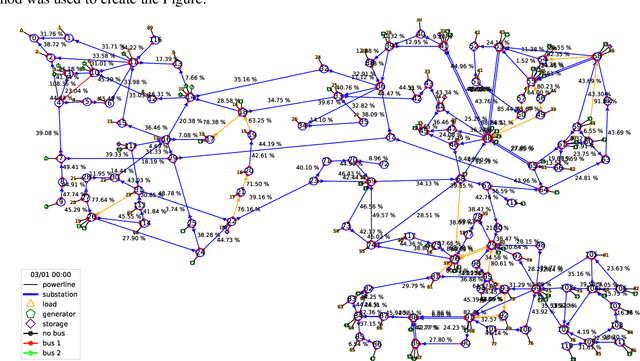
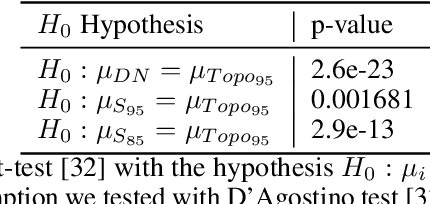
Abstract:With the growth of Renewable Energy (RE) generation, the operation of power grids has become increasingly complex. One solution is automated grid operation, where Deep Reinforcement Learning (DRL) has repeatedly shown significant potential in Learning to Run a Power Network (L2RPN) challenges. However, only individual actions at the substation level have been subjected to topology optimization by most existing DRL algorithms. In contrast, we propose a more holistic approach in this paper by proposing specific Target Topologies (TTs) as actions. These topologies are selected based on their robustness. As part of this paper, we present a search algorithm to find the TTs and upgrade our previously developed DRL agent CurriculumAgent (CAgent) to a novel topology agent. We compare the upgrade to the previous CAgent agent and can increase their scores significantly by 10%. Further, we achieve a 25% better median survival with our TTs included. Later analysis shows that almost all TTs are close to the base topology, explaining their robustness.
AudioProtoPNet: An interpretable deep learning model for bird sound classification
Apr 16, 2024Abstract:Recently, scientists have proposed several deep learning models to monitor the diversity of bird species. These models can detect bird species with high accuracy by analyzing acoustic signals. However, traditional deep learning algorithms are black-box models that provide no insight into their decision-making process. For domain experts, such as ornithologists, it is crucial that these models are not only efficient, but also interpretable in order to be used as assistive tools. In this study, we present an adaption of the Prototypical Part Network (ProtoPNet) for audio classification that provides inherent interpretability through its model architecture. Our approach is based on a ConvNeXt backbone architecture for feature extraction and learns prototypical patterns for each bird species using spectrograms of the training data. Classification of new data is done by comparison with these prototypes in latent space, which simultaneously serve as easily understandable explanations for the model's decisions.
BirdSet: A Multi-Task Benchmark for Classification in Avian Bioacoustics
Mar 15, 2024
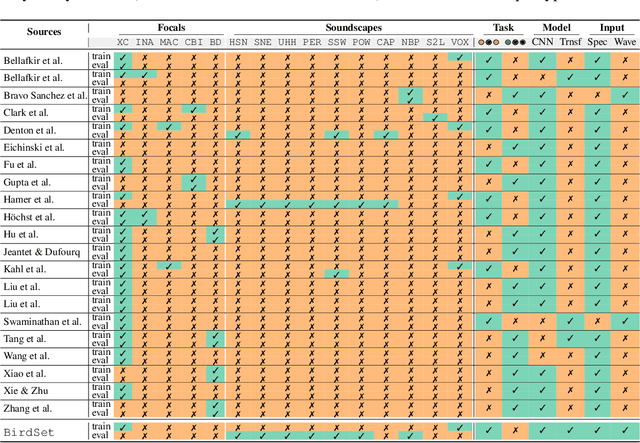

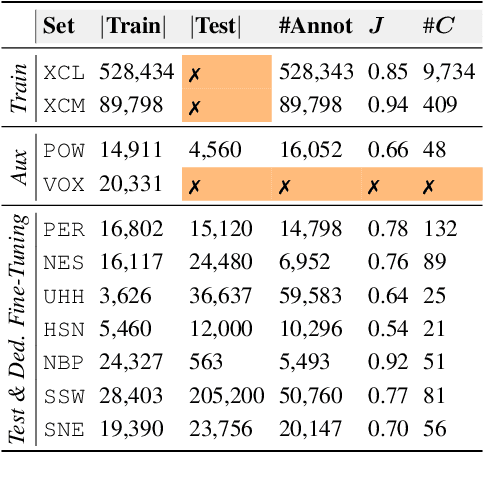
Abstract:Deep learning (DL) models have emerged as a powerful tool in avian bioacoustics to diagnose environmental health and biodiversity. However, inconsistencies in research pose notable challenges hindering progress in this domain. Reliable DL models need to analyze bird calls flexibly across various species and environments to fully harness the potential of bioacoustics in a cost-effective passive acoustic monitoring scenario. Data fragmentation and opacity across studies complicate a comprehensive evaluation of general model performance. To overcome these challenges, we present the BirdSet benchmark, a unified framework consolidating research efforts with a holistic approach for classifying bird vocalizations in avian bioacoustics. BirdSet harmonizes open-source bird recordings into a curated dataset collection. This unified approach provides an in-depth understanding of model performance and identifies potential shortcomings across different tasks. By establishing baseline results of current models, BirdSet aims to facilitate comparability, guide subsequent data collection, and increase accessibility for newcomers to avian bioacoustics.
Active Bird2Vec: Towards End-to-End Bird Sound Monitoring with Transformers
Aug 14, 2023
Abstract:We propose a shift towards end-to-end learning in bird sound monitoring by combining self-supervised (SSL) and deep active learning (DAL). Leveraging transformer models, we aim to bypass traditional spectrogram conversions, enabling direct raw audio processing. ActiveBird2Vec is set to generate high-quality bird sound representations through SSL, potentially accelerating the assessment of environmental changes and decision-making processes for wind farms. Additionally, we seek to utilize the wide variety of bird vocalizations through DAL, reducing the reliance on extensively labeled datasets by human experts. We plan to curate a comprehensive set of tasks through Huggingface Datasets, enhancing future comparability and reproducibility of bioacoustic research. A comparative analysis between various transformer models will be conducted to evaluate their proficiency in bird sound recognition tasks. We aim to accelerate the progression of avian bioacoustic research and contribute to more effective conservation strategies.
Managing power grids through topology actions: A comparative study between advanced rule-based and reinforcement learning agents
Apr 17, 2023
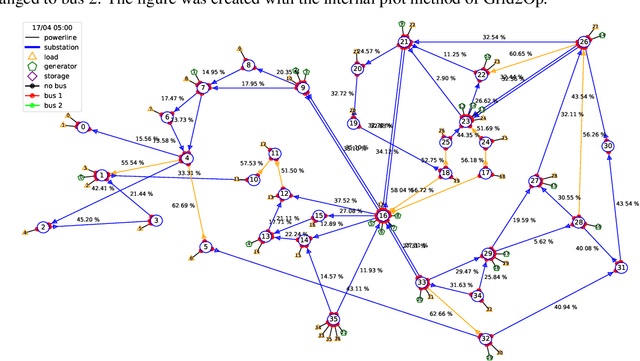

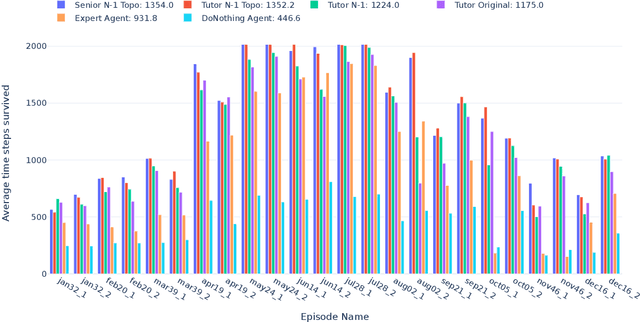
Abstract:The operation of electricity grids has become increasingly complex due to the current upheaval and the increase in renewable energy production. As a consequence, active grid management is reaching its limits with conventional approaches. In the context of the Learning to Run a Power Network challenge, it has been shown that Reinforcement Learning (RL) is an efficient and reliable approach with considerable potential for automatic grid operation. In this article, we analyse the submitted agent from Binbinchen and provide novel strategies to improve the agent, both for the RL and the rule-based approach. The main improvement is a N-1 strategy, where we consider topology actions that keep the grid stable, even if one line is disconnected. More, we also propose a topology reversion to the original grid, which proved to be beneficial. The improvements are tested against reference approaches on the challenge test sets and are able to increase the performance of the rule-based agent by 27%. In direct comparison between rule-based and RL agent we find similar performance. However, the RL agent has a clear computational advantage. We also analyse the behaviour in an exemplary case in more detail to provide additional insights. Here, we observe that through the N-1 strategy, the actions of the agents become more diversified.
 Add to Chrome
Add to Chrome Add to Firefox
Add to Firefox Add to Edge
Add to Edge